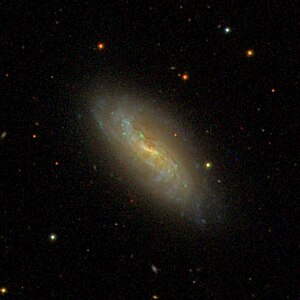NGC 701
aus Wikipedia, der freien Enzyklopädie
| Galaxie NGC 701 | |
|---|---|

| |
| SDSS-Aufnahme | |
| AladinLite | |
| Sternbild | Walfisch |
| Position Äquinoktium: J2000.0, Epoche: J2000.0 | |
| Rektaszension | 01h 51m 03,8s[1] |
| Deklination | −09° 42′ 09″[1] |
| Erscheinungsbild | |
| Morphologischer Typ | SB(rs)c / HII / Sbrst[1] |
| Helligkeit (visuell) | 12,2 mag[2] |
| Helligkeit (B-Band) | 12,9 mag[2] |
| Winkelausdehnung | 2,6′ × 1,4′[2] |
| Positionswinkel | 40°[2] |
| Flächenhelligkeit | 13,5 mag/arcmin²[2] |
| Physikalische Daten | |
| Zugehörigkeit | LGG 33[1][3] |
| Rotverschiebung | 0.006104 ± 0.000009[1] |
| Radialgeschwindigkeit | (1830 ± 3) km/s[1] |
| Hubbledistanz H0 = 73 km/(s • Mpc) |
(83 ± 6) · 106 Lj (25,3 ± 1,8) Mpc [1] |
| Durchmesser | 65.000 Lj[4] |
| Geschichte | |
| Entdeckung | Wilhelm Herschel |
| Entdeckungsdatum | 10. Januar 1785 |
| Katalogbezeichnungen | |
| NGC 701 • PGC 6826 • MCG -02-05-060 • IRAS 01485-0957 • 2MASX J01510384-0942093 • GC 418 • H I 62 • h 160 / 2442 • HIPASS J0151-09 • LDCE 112 NED002 • Holm 47A | |
NGC 701 ist eine aktive Balken-Spiralgalaxie vom Hubble-Typ SBc mit hoher Sternentstehungsrate im Sternbild Walfisch südlich der Ekliptik. Sie ist schätzungsweise 83 Millionen Lichtjahre von der Milchstraße entfernt und hat einen Durchmesser von etwa 65.000 Lichtjahren. Gemeinsam mit NGC 681, PGC 6667 und IC 1738 bildet sie die PGC 6667-Gruppe.
Im selben Himmelsareal befinden sich u. a. die Galaxien NGC 681 und IC 1738.
Die Typ-IIP-Supernova SN 2004fc wurde hier beobachtet.[5]
Das Objekt wurde am 10. Januar 1785 von dem deutsch-britischen Astronomen Wilhelm Herschel entdeckt.[6]
Weblinks
[Bearbeiten | Quelltext bearbeiten]- SIMBAD Astronomical Database
- Auke Slotegraaf: NGC 701. Deep Sky Observer's Companion, abgerufen am 19. September 2015 (englisch).
- CDS Portal
Einzelnachweise
[Bearbeiten | Quelltext bearbeiten]Text is available under the CC BY-SA 4.0 license; additional terms may apply.
Images, videos and audio are available under their respective licenses.
